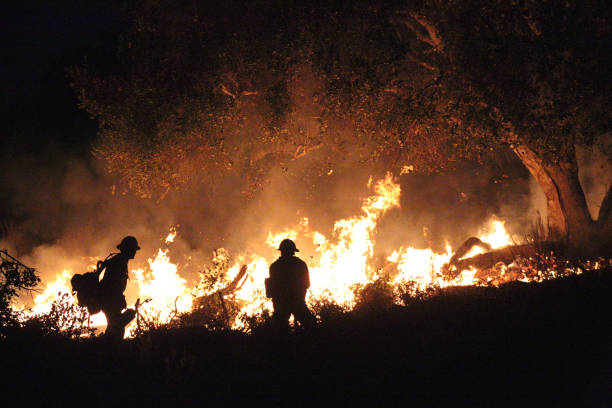
Flames rage across the Los Angeles landscape, consuming homes, forests and lives in their wake. Ravaging about 40,500 acres of land, this is not merely a natural disaster—the wildfires stand as a clear cut warning of the dire implications of climate change.
Entire ecosystems have been reduced to ash, and communities have been forced to flee as the flames continue to spread. Over the past few decades, the Los Angeles region has witnessed an alarming increase in the frequency, intensity and scale of these fires. There have been 8 fires in the Los Angeles area, and 16 fires in total in southern California. This shift has been directly linked to global heating caused by the burning of fossil fuels, which has exacerbated the conditions for wildfires in the region.
Recent research highlights the significant role of climate change in making wildfire conditions more likely and extreme. The hot, dry and windy conditions that fuel wildfires in Los Angeles have become 35% more likely due to global warming caused by fossil fuel emissions. Rising temperatures have intensified droughts, leading to drier landscapes and more combustible vegetation. One recent example is the November 8 drought-driven wildfires near New York City, where unseasonably dry conditions fueled unexpected blazes. The city had declared a drought warning, and this dry weather resulted in wildfires from Brooklyn to Upper Manhattan and New Jersey. Scientists claim that droughts are more likely to happen these days because of climate change, and they are about to become more severe.
Moreover, the absence of rainfall typically expected between October and December has become about 2.4 times more likely than it was in the preindustrial era. Historically, this rainfall was key to ending the wildfire season in the region. However, as climate change continues to intensify, rainfall patterns have grown more erratic, which extends the fire season.
An estimate by J.P Morgan presents that the insured losses from fire may exceed $20 billion, and the total costs could reach up to $50 billion. Yet, the consequences of the wildfire go way beyond economic losses. News reports hint at the startling number of casualties caused by the fires. The Palisades and Eaton wildfires have consumed at least 15,467 structures, and this number is still on the rise. While there had been 200,000 evacuations at the peak of the crisis, the death toll amounts to 29 people. Although humans tend to focus on what happens in their own lives and communities, it is important to acknowledge that the wildfires have devastated entire ecosystems, decimating plant and animal populations alike. In Pasadena, a reporter and a photographer helped a woman rescue her chickens from her burning home. There are no exact number of animals being affected by the wildfires, but non-profit Pasadena Humane reports that they have rescued over 300 domestic animals from the fire. But not all are lucky—there are countless videos of animals wandering aimlessly around the engulfing flames, with nowhere to go. While it may be true that the LA wildfires are the costliest fires in history, there is much more at stake than just money.
The LA wildfires have a lot of hidden consequences. For one, studies show that exposure to wildfire smoke, ash, and debris poses hidden health risks, with long-term effects on respiratory and cardiovascular health. Even brief contact with polluted air can increase the risk of chronic diseases and exacerbate existing conditions. The wildfires generate massive amounts of hazardous waste too. Cleanup efforts become an environmental challenge of their own, as burned materials—including plastics, metals, and industrial waste—contaminate the land and water. These lingering pollutants pose long-term health risks to both humans and wildlife.
The Los Angeles wildfires highlight the urgent need for climate action. Reducing carbon emissions, protecting wildlife and improving land management are crucial to mitigating future disasters. Without intervention, both human and animal lives will suffer. Addressing climate change now is essential for a safer, more sustainable future.
The LA wildfires have ravaged about 40,000 acres of land, killed 30 people, and declined an uncountable number of animal and plant life. This is not merely a natural disaster; the wildfires stand as a clear cut warning of the dire implications of climate change.
Entire ecosystems have been reduced to ash, and communities have been forced to flee as the flames continue to spread. Over the past few decades, the region has witnessed an alarming increase in the frequency, intensity, and scale of these fires. This shift has been directly linked to global heating caused by the burning of fossil fuels, which has exacerbated the conditions for wildfires in the region.
Recent research highlights the significant role of climate change in making wildfire conditions more likely and extreme. The hot, dry, and windy conditions that fuel wildfires in Los Angeles have become 35% more likely due to global warming caused by fossil fuel emissions. Rising temperatures have intensified droughts, leading to drier landscapes and more combustible vegetation. One recent example is the November 8 drought-driven wildfires near New York City, where unseasonably dry conditions fueled unexpected blazes. The city had declared a drought warning, and this dry weather resulted in wildfires from Brooklyn to Upper Manhattan and New Jersey. Scientists claim that droughts are more likely to happen these days because of climate change, and they are about to become more severe.
Moreover, the rainfall typically expected between October and December has become about 2.4 times more likely than it was in the preindustrial era. Historically, this rainfall was key to ending the wildfire season in the region. However, as climate change continues to intensify, rainfall patterns have grown more erratic, which extends the fire season.
The consequences of these fires go far beyond immediate destruction. The loss of vegetation leaves herbivores struggling for food, leading to declines in predator populations. Soil erosion, worsened by the loss of plant life, contaminates water sources, endangering aquatic ecosystems. Many species, including mountain lions, bobcats, and migratory birds, are either displaced or killed in the fires, pushing already vulnerable populations closer to extinction. Smaller animals, unable to outrun the flames, are often wiped out in mass numbers, further disrupting fragile ecosystems.
Additionally, the wildfires generate massive amounts of hazardous waste. The destruction of homes, businesses, and infrastructure releases toxic chemicals into the air and soil. Cleanup efforts become an environmental challenge of their own, as burned materials—including plastics, metals, and industrial waste—contaminate the land and water. These lingering pollutants pose long-term health risks to both humans and wildlife.
The Los Angeles wildfires highlight the urgent need for climate action. Reducing carbon emissions, protecting wildlife, and improving land management are crucial to mitigating future disasters. Without intervention, both human and animal lives will suffer. Addressing climate change now is essential for a safer, more sustainable future.
 [/vc_column_text][/vc_column][/vc_row]
[/vc_column_text][/vc_column][/vc_row]